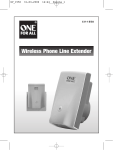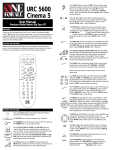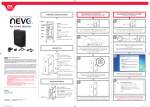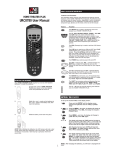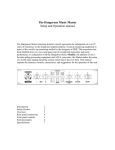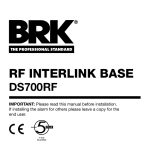Download one for all sv 1710 video sender
Transcript
SV-1710 702363 UK D F E P I NL SF S DK N Wireless Audio Video Sender 1 TRANSMITTER RECEIVER OFF OFF OFF ON 2 TRANSMITTER TRANSMITTER Aligned A B IR-receiver 3 RECEIVER RECEIVER WWW.ONEFORALL.COM 3 UK Table of Contents UK The Product . . . . . . . . . . . . . . . . . . . . . . . . . . . . . . . . . . . . . . . . . . . . . . . . . . . . . . . 5 Installation . . . . . . . . . . . . . . . . . . . . . . . . . . . . . . . . . . . . . . . . . . . . . . . 6 Getting started ........................................ 7 Trouble Shooting . . . . . . . . . . . . . . . . . . . . . . . . . . . . . . . . . . . . . . . . . . . . . . . . . . 8 Customer Service . . . . . . . . . . . . . . . . . . . . . . . . . . . . . . . . . . . . . . . . . . . . . . . . . . 8 Thank You Thank you for purchasing the ONE FOR ALL Wireless Audio Video (AV) Sender (SV-1710). ONE FOR ALL is continuously striving to develop, produce and market high quality innovative products to remotely control your equipment. We hope the Wireless AV Sender will give you the freedom of wireless control. Your ONE FOR ALL Wireless AV Sender can be connected to all your audio and video equipment. Safety Precautions - - - Do not attempt to service this product; in case of technical difficulties, mail to [email protected] (just send blank message, you will get auto-reply). This product should only be used with the AC power adapters included or a type that complies with safety standard EN60065 and that has the following specification: 18 Volt DC / 300mA. This product should not be exposed to high temperatures. This product should not be used in damp places or close to water. The AC power adapters should only be connected to a power supply of 220-240 VAC / 50Hz. This product should not be covered. Inadequately protected or sensitive electronic equipment may be affected by the use of this product. This interference can lead to damage to either equipment. Before you start, please check whether or not this product can affect surrounding equipment. WWW.ONEFORALL.COM 4 The Product The Wireless Audio Video Sender (SV-1710) is a solution for distributing audio and video signals to every place in the house without the need of wires. The AV Sender gives you the possibility to view any video source (satellite receiver, video recorder, camcorder, DVD player, digital or analogue Set-Top Box or Pay-TV decoder box) on your second TV in your home. The - ONE FOR ALL Wireless AV Sender (SV-1710) package contains: TRANSMITTER unit RECEIVER unit Infra-red (IR) Eye Two Power adapters Two “RCA to SCART” cables The TRANSMITTER sends the audio and video signals from the source device (VCR, DVD, SATELLITE/ CABLE BOX, CAMCORDER, etc) by 2.4 GHz to the RECEIVER that is connected to the destination device. The built in Remote Control Extender sends the IR signal in the opposite direction (from RECEIVER unit to TRANSMITTER unit) at a frequency of 433.92 MHz. TRANSMITTER The TRANSMITTER operates on 18 Volts DC 300mA that is supplied by the AC/DC Adapter (included in package). Connecting from the audio or video device to the TRANSMITTER is done by an RCA to SCART cable (included in package). The Audio and/or video signals are transformed to a 2.4GHz frequency that will be sent via the built-in antenna. Furthermore the TRANSMITTER transforms the Remote Control Extender signal (at 433.92 MHz) back to an IR command. RECEIVER The RECEIVER operates on 18 Volts DC 300mA that is supplied by the AC/DC Adapter (included in package). Connecting from the audio or video device to the RECEIVER is done by an RCA to SCART cable (included in package). The high frequency signal (2.4GHz) received by this unit are captured by the built-in antenna of the RECEIVER unit and will be transformed into the original audio and video signals. Secondly the RECEIVER has a built in remote control extender. When an infra red signal is Received by the RECEIVER, it will transform the IR command to 433.92 MHz and can be sent through walls and ceilings. Please note that this feature is only accessable for devices that are controlled via IR (infra-red) signals at a frequency of 30 - 60 kHz. This feature does not support the 2-way IRDA waveform. If you are unsure of the details of the remote control (IR) output, please refer to the manual of the original device or contact your cable supplier. WWW.ONEFORALL.COM 5 Installation See page 3 (fold-out page) 1 Before starting the installation make sure that both the TRANSMITTER and RECEIVER are switched off. TRANSMITTER OFF 2 RECEIVER OFF OFF ON Connecting the TRANSMITTER Use the cable labeled “TRANSMITTER”. Connect the RCA-plugs (Red, White and Yellow) to the corresponding connectors of the TRANSMITTER unit. Connect the SCART connector to the device that you select for supplying the picture (source device). Make sure that the SCART is connected to the correct Output of the device, normally called “Line Out”. If you wish to remotely control the source device (satellite receiver, video recorder, camcorder, DVD player, digital or analogue Set-Top Box or Pay-TV decoder box) from another room, for example to change channels on your satellite receiver, you will need to either: A Place the TRANSMITTER on top of the source device. Make sure that the front side of the TRANSMITTER is aligned with the front side of the source device. OR B Place the TRANSMITTER next/close to the source device and connect the IR eye to the TRANSMITTER. Place the IR eye directly on the IR receiver window on the front-side of the source device OR in front of the source device (make sure there is no interference of the IR Eye signal going to the IR receiver of the source device). Now, insert the adapter plug into the connector on the backside. 3 Connecting the RECEIVER Use the cable labeled “RECEIVER”. Connect the RCA-plugs (Red, White and Yellow) to the corresponding connectors of the RECEIVER unit. Connect the SCART connector to the device you selected for displaying the picture (destination). Make sure that the SCART is connected to the correct Input of the device, normally called “Line In”. Insert the adapter plug into the connector on the backside. If you want to control the source device, place the RECEIVER on top or beside the destination device where it is able to catch the IR command from your remote control. 6 WWW.ONEFORALL.COM Getting Started Now that both units are connected you can switch ON the units using the ON/OFF switch. The red LED on the front should light up. Place the units as high as possible to avoid interference of any kind. OFF ON TRANSMITTER ON RECEIVER ON The following paragraphs contain a few examples. EXAMPLE 1: Play video on the VCR (source) in the living room and watch the picture on the TV (destination) in the bedroom. Connect the TRANSMITTER to the VCR and the RECEIVER to the TV in the bedroom. Switch on the video and insert a tape. Place the TRANSMITTER on top of the VCR (aligned; see A) OR the IR eye on / in front of the IR receiver of the VCR (see B). Switch on the TV in the bedroom. Select the mode on the TV for “Line In” (AV, EXT or channel 0). Aim the VCR remote control (or a universal remote control) to the RECEIVER unit and press play. The video should start playing and picture and sound should appear on your bedroom TV screen. EXAMPLE 2: If you do not have coax cable connection with the TV in the bedroom you can tune in the channels on your VCR (source) in the living room and watch the picture on the TV (destination) in the bedroom. You may need the manual of your VCR to tune in the TV channels. Once all channels are tuned in, you are able to watch your TV channels through your AV channel. Connect the TRANSMITTER to the VCR and the RECEIVER to the TV in the bedroom. Switch on the video. Place the TRANSMITTER on top of the VCR (see A) OR the IR eye on / in front of the IR receiver of the VCR (see B). Switch on the TV in the bedroom. Select the mode on the TV for “Line In” (AV, EXT or channel 0). You can take the remote of your VCR (or a ONE FOR ALL universal remote) to your bedroom to control your TV channels tuned in your VCR. EXAMPLE 3: Also, if you do not have coax cable connection with the TV in the bedroom, the AV Sender gives the possibility to view your Satellite Receiver (source) programs also on the TV (destination) in the bedroom. You probably already tuned in the channels on your Satellite Receiver. If not, you may need the manual of your Satellite Receiver to tune in the TV channels. Once all channels are tuned in, you are able to watch your TV channels through your AV channel (or other output channel). Connect the TRANSMITTER to the Satellite Receiver and the RECEIVER to the TV in the bedroom. Switch on the Satellite Receiver. Place the TRANSMITTER on top of the Satellite Receiver (see A) OR the IR eye on / in front of the IR receiver of the Satellite Receiver (see B). Switch on the TV in the bedroom. Select the mode on the TV for “Line In” (AV, EXT or channel 0). You can take the remote of your Satellite Receiver (or a ONE FOR ALL universal remote) to your bedroom to control your TV channels tuned in your Satellite Receiver. WWW.ONEFORALL.COM 7 Trouble Shooting Problem & Solution If your house has a heavy metal construction or is equipped with a PC network, it can disturb the radio signal. Even moving the units a few inches can improve the performance. If this doesn’t work try to move the TRANSMITTER and RECEIVER to another place in the house. If you experience problems, try placing the units away from electrical appliances. • No picture on second TV. - Make sure that the TRANSMITTER and RECEIVER are switched ON. - Select “EXT” or “AV” on second TV. - Make sure that all cables are connected correctly. - Make sure that the video source (satellite receiver, video recorder, camcorder, DVD player, digital or analogue Set-Top Box or Pay-TV decoder box) is switched on. - Make sure to use the correct SCART connector of the video source (check manual of video source. Example: EXT1 or EXT2). • Bad picture/ sound quality on second TV. - Try to find out if the way the cables are placed cause interference. - Make sure that the distance between the TRANSMITTER and RECEIVER unit is less than 100 ft (30 m). • Picture of selected TV channel disappears (snow-picture). - Disable the auto standby mode of the VCR. (check the manual of the VCR how to do this). • The picture on your second TV is not correct. - Select “EXT” or “AV” on second TV. - Make sure that the video source is switched on. • Using a remote control, you cannot control the video source from your second TV. - Aim the remote control directly at the RECEIVER unit and ensure that there are no obstacles in between. - Ensure that there is no other wireless device (wireless headphones, speakers, RF control signals) interfering with the remote control. - Make sure that TRANSMITTER and RECEIVER are more than 16 ft (5 m) apart. - Make sure to use the remote control of the video source. - Reposition the IR Eye on the video source OR place the IR Eye 2 - 4 inch (5 - 10 cm) in front of the video source. • Buzzing sound when using the remote control - With some types of TV you will not be able to solve this problem. • S-VHS video shows no colour pictures (only black and white). - Select CVBS video output format for your S-VHS VCR • DVD player gives no pictures on either main- or second TV. - Select CVBS video output format for your DVD player (check the DVD player’s user manual. Customer Service Please read the instruction manual carefully. If you still experience problems operating the Wireless Audio Video Sender (SV-1710) you may contact us at: - [email protected] (Just send blank message, you will get auto-reply) - www.oneforall.com 8 WWW.ONEFORALL.COM







